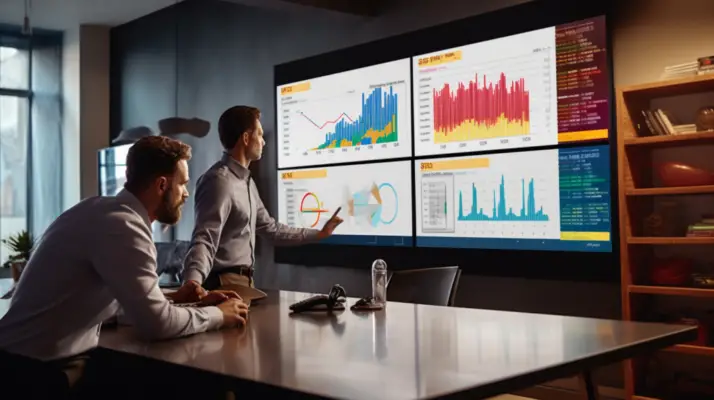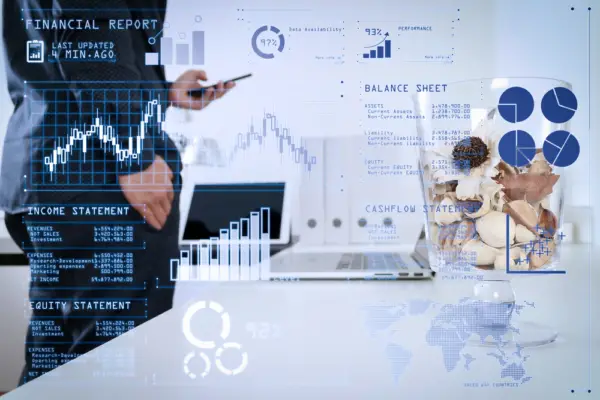Key Risk Indicators (KRIs) are critical predictive indicators of potential risk in various areas of an organization. They provide early warnings about the potential risk that might harm the ability of the organization to achieve its objectives. KRIs are used in risk management to identify potential issues and problems before they occur, allowing organizations to take corrective action in advance.
Here are some characteristics of good KRIs:
- Predictive: They should indicate an increased risk before the issue has occurred. This allows for preventative action.
- Relevant: They should be related to the key risks the organization has identified as important.
- Measurable: They should be quantifiable in some way. This might be a percentage, a number, a score, or some other metric.
- Actionable: They should be something the organization can act upon. If nothing can be done about the risk, it’s not a useful KRI.
- Timely: They should provide data in a timeframe that allows for action to be taken.
For example, a KRI might be the number of failed transactions in a banking context, indicating a risk to customer satisfaction and operational performance. If this number starts to rise, it might indicate a problem with the system that needs to be addressed.
It’s important to note that KRIs are about potential future risk, not about what’s happening right now. They are a tool for predicting and preventing issues, not responding to them.
As technology advances, the importance of cybersecurity risk management cannot be overstated. Our organization recognizes the critical need to identify and measure key risk indicators (KRIs) to manage risk effectively.
KRIs provide valuable insights into potential threats and vulnerabilities that could compromise our IT systems and data, allowing us to mitigate risk proactively.
This article will explore the definition of KRIs, their significance in enterprise risk management, and the characteristics of good KRIs. We will also provide examples of KRIs and examine the challenges of developing effective Key Risk Indicators.
Additionally, we will discuss the latest trends in cybersecurity, based on GARTNER research, and introduce EGERIE, a leading European software editor that offers risk-based cybersecurity programs and services.

IT Key Risk Indicators Examples
Key Risk Indicators (KRIs) in Information Technology (IT) can help monitor and predict potential issues that could negatively impact an organization’s IT infrastructure, security, or overall operational efficiency. Here are some examples:
Number of Unpatched Systems: This can indicate a risk to the organization’s security. If this number is high, it could mean that the organization is more vulnerable to attacks.
Incidents of Data Breach: The frequency of data breaches can indicate risks to data security and potentially lead to loss of customer trust, legal issues, and financial losses.
System Downtime: The amount of time systems are unavailable can impact productivity and customer satisfaction. High system downtime could be a risk indicator of infrastructure issues.
Number of Failed Logins: A high number of failed login attempts could indicate a risk of attempted unauthorized access to systems.
Software Development Lifecycle (SDLC) Deviations: Deviations from established SDLC processes can lead to poor quality software, introducing risks of software failure and security issues.
IT Compliance Violations: The number of IT compliance violations can indicate a risk to the organization’s reputation and potential legal issues.
Average Time to Resolve IT Incidents: A high average time to resolve IT incidents may indicate inefficiencies in the IT department and potentially impact business operations.
Number of Outdated Software Components: Using outdated software can expose the organization to vulnerabilities addressed in later versions, posing a security risk.
Understanding KRIs
Understanding KRIs is crucial in enterprise risk management as they provide advance notice of potential risks and insight into weaknesses in monitoring and control tools, allowing for ongoing risk monitoring to mitigate potential threats.
KRIs are metrics used to measure the likelihood of an event and the consequences of it exceeding an organization’s risk appetite, which could negatively impact its success. Good KRIs are characterized by a deep knowledge of the organization, identification of critical attributes, risks, threats, and vulnerabilities, and metrics to identify serious threats.
Key risk is differs from KPIs in that KPIs assess progress toward goals, while KRIs assess the likelihood and consequences of potential risks.
Developing Key Risk Indicators can be challenging due to the need for accurate information, identifying and quantifying risks, securing senior management support, linking critical business attributes to risk scenarios, creating measurable metrics, and establishing ongoing monitoring and response actions.
Nonetheless, Key Risk Indicators are essential in enterprise risk management, enabling organizations to monitor and mitigate potential threats.
KRIs are an essential aspect of enterprise risk management that provides organizations with crucial insights into potential risks and weaknesses in their monitoring and control tools. These metrics enable organizations to monitor potential threats, identify critical attributes, and establish response actions to mitigate risks.
Despite the challenges associated with developing KRIs, they remain vital for organizations to ensure the success and sustainability of their operations.
Importance in Risk Management
Effective management of potential threats and vulnerabilities is crucial for organizations to ensure their success and protect against negative impacts exceeding their risk appetite. Key risk indicators (KRIs) play a critical role in enterprise risk management by providing advance notice of potential risks, insights into weaknesses in monitoring and control tools, and ongoing risk monitoring.
Key risk indicators enable organizations to identify risks, threats, and vulnerabilities and measure the likelihood of events and consequences exceeding their risk appetite. A deep understanding of the organization characterizes good KRIs, identifying critical attributes, risks, threats, vulnerabilities, and metrics to identify serious threats.
Key Risk Indicators are distinct from key performance indicators (KPIs) that measure progress toward goals. Developing KRIs can be challenging, requiring accurate information, quantification of risks, senior management support, linking critical business attributes to risk scenarios, measurable metrics, and ongoing monitoring and response actions.
Gartner’s research suggests that secure and proactive organizations will reduce security breaches by 66% by 2026. Organizations must balance investments across technology, structural, and human-centric elements in their cybersecurity programs to achieve this.
Human-centric security design practices are expected to be adopted by 50% of large enterprise CISOs by 2027. EGERIE, a leading European software editor, provides a platform for risk-based cybersecurity programs, including services like Risk Manager and Privacy Manager.
EGERIE’s white paper on cyber risk as a strategic asset offers valuable insights for organizations looking to industrialize their risk-based cybersecurity programs.

Characteristics of Good KRIs
Firstly, they have a deep knowledge of the organization’s operations and risk appetite. This knowledge allows KRIs to identify critical attributes, risks, threats, and vulnerabilities essential to developing proper risk mitigation strategies.
Secondly, good Key Risk Indicators have metrics that allow them to identify serious threats and provide advance notice of potential risks. These measurable metrics provide a quantitative understanding of the risk level, allowing for more effective risk management.
Lastly, good KRIs link critical business attributes to risk scenarios, making creating measurable metrics easier and establishing ongoing monitoring and response actions. These actions help to mitigate risks and minimize the negative impact of potential threats.
Developing good Key Risk Indicators can be challenging, but ensuring the organization is adequately prepared for potential risks is essential. Obtaining accurate information, identifying and quantifying risks, securing senior management support, and creating measurable metrics are some challenges associated with developing KRIs.
However, overcoming these challenges and developing effective Key Risk Indicators is crucial to provide insight into weaknesses in monitoring and control tools and ongoing risk monitoring.
Examples of KRIs
In real-world scenarios, customer complaints can serve as a Key Risk Indicator for retail sales organizations. These complaints can provide valuable insights into the strengths and weaknesses of a company’s products or services and any potential risks that could negatively impact the organization’s success.
Another example of a Key Risk Indicator is the number of failed login attempts for an organization’s IT systems. This Key Risk Indicator can help identify potential cyber threats and attacks, as multiple failed login attempts could indicate that someone’s attempting to gain unauthorized access to the organization’s systems.
A third example of a Key Risk Indicator is the time it takes for an organization to respond to a security incident. This Key Risk Indicator can help identify weaknesses in an organization’s incident response plan and provide insights into the organization’s overall security posture.
Monitoring this Key Risk Indicator and implementing appropriate incident response measures, organizations can minimize the impact of security incidents and reduce the likelihood of future incidents.
Challenges in Developing KRIs
Developing Key Risk Indicators can be daunting, as accurately identifying and quantifying potential risks, securing senior management support, and establishing measurable metrics require careful consideration and planning. There are several challenges associated with developing KRIs that organizations must overcome to ensure that their KRIs are effective in mitigating risks.
One of the main challenges is obtaining accurate information, which can be difficult due to the complex nature of modern business operations. Additionally, identifying and quantifying risks requires a deep understanding of the organization, its operations, and the associated risks. This can be challenging for organizations that lack the necessary knowledge and resources.
Another challenge associated with developing KRIs is securing senior management support. KRIs are an essential component of an organization’s risk management program, and without executive buy-in, it can be challenging to establish effective Key Risk Indicators. Senior management support is necessary to ensure that KRIs are aligned with the organization’s risk appetite and to provide the necessary resources for ongoing monitoring and response actions.
Establishing measurable metrics is a critical component of developing effective Key Risk Indicators. Metrics are necessary to identify serious threats and to provide ongoing risk monitoring. However, creating measurable metrics requires linking critical business attributes to risk scenarios, which can be challenging for organizations that lack the necessary knowledge and resources.
Additionally, establishing ongoing monitoring and response actions requires a deep understanding of the organization’s operations and the associated risks, which can be difficult to achieve without the necessary resources and expertise.
| Challenge | Description | Solution |
|---|---|---|
| Obtaining accurate information | Accurately identifying and quantifying potential risks | Develop a deep understanding of the organization’s operations and the associated risks |
| Securing senior management support | Ensuring executive buy-in for KRIs | Align KRIs with the organization’s risk appetite and provide the necessary resources for ongoing monitoring and response actions |
| Establishing measurable metrics | Creating measurable metrics that identify serious threats and provide ongoing risk monitoring | Align KRIs with the organization’s risk appetite and provide the necessary resources for ongoing monitoring and response actions. |
Frequently Asked Questions
What are some common mistakes to avoid when developing KRIs?
When developing Key Risk Indicators, we must avoid common mistakes such as relying solely on qualitative data, failing to involve key stakeholders, and neglecting to update Key Risk Indicators regularly. It’s important to have accurate metrics and ongoing monitoring to identify potential risks.
How do KRIs differ from other types of risk monitoring metrics?
Kris differs from other types of risk monitoring metrics by specifically measuring the likelihood and consequences of events exceeding an organization’s risk appetite. They differ from KPIs, which assess progress toward goals. Good KRIs have measurable metrics and identify critical attributes, risks, threats, and vulnerabilities.
Can KRIs be used in industries other than finance and cybersecurity?
Key Risk Indicators can be used in industries beyond finance and cybersecurity. By identifying critical attributes, risks, threats, and vulnerabilities and creating measurable metrics, KRIs can provide advance notice of potential risks and ongoing risk monitoring in any organization.
What role do KRIs play in overall risk management strategy?
Key Risk Indicators are essential in our overall risk management strategy. They provide advance notice of potential risks and insight into weaknesses in monitoring and control tools. Good KRIs identify critical attributes, risks, threats, and vulnerabilities and establish ongoing monitoring and response actions.
How can companies ensure ongoing monitoring and adjustment of KRIs to adapt to changing risk environments?
To ensure ongoing monitoring and adjustment of KRIs, we regularly review and update our risk assessment process, gather stakeholder feedback, and stay informed on industry trends and emerging risks. We also prioritize communication and collaboration across departments to ensure a comprehensive and adaptive approach to risk management.

Conclusion
Key Risk Indicators are essential in managing cybersecurity risks and ensuring the safety and security of an organization’s valuable assets. Organizations can proactively mitigate potential threats and vulnerabilities by identifying and measuring key risk indicators, minimizing the risk of cyber-attacks and data breaches.
Good Key Risk Indicators should be relevant, measurable, and timely, providing actionable insights that enable informed decision-making. However, developing effective KRIs can be challenging, requiring a comprehensive understanding of the organization’s risk landscape and a deep knowledge of cybersecurity trends and best practices.
That’s where EGERIE provides risk-based cybersecurity programs and services that help organizations develop and implement effective risk management strategies. As cybersecurity threats continue to evolve, it’s more important than ever for organizations to prioritize risk management and leverage KRIs to mitigate potential risks and protect their valuable assets.

Chris Ekai is a Risk Management expert with over 10 years of experience in the field. He has a Master’s(MSc) degree in Risk Management from University of Portsmouth and is a CPA and Finance professional. He currently works as a Content Manager at Risk Publishing, writing about Enterprise Risk Management, Business Continuity Management and Project Management.

